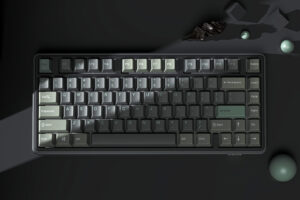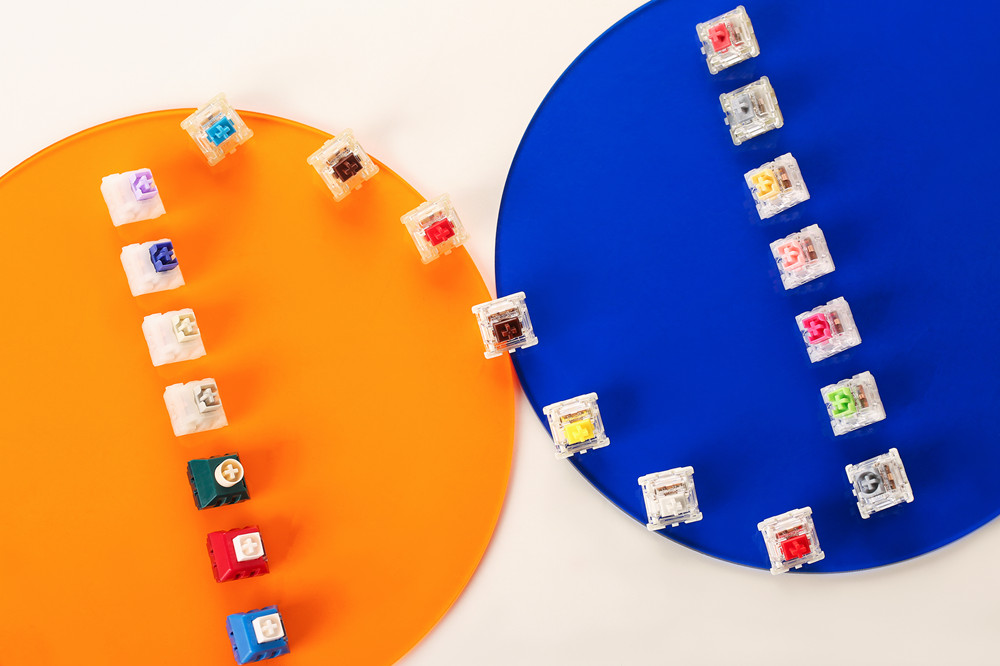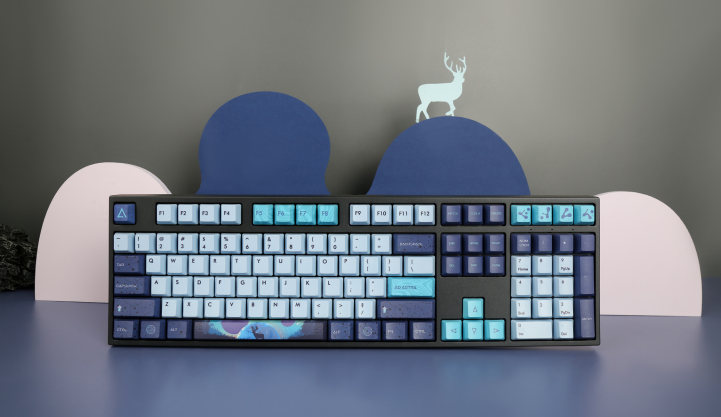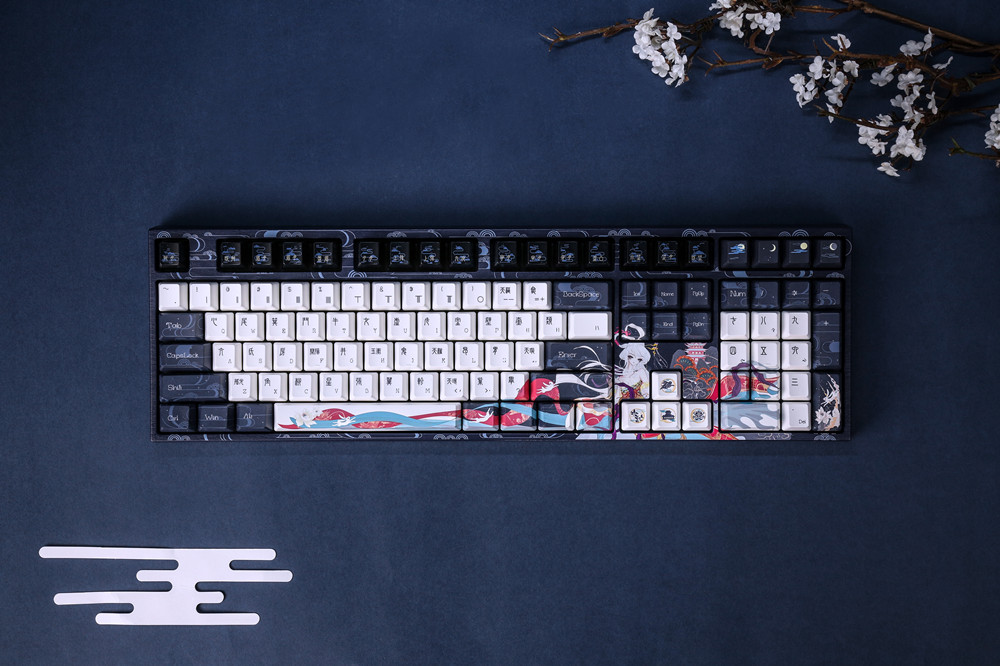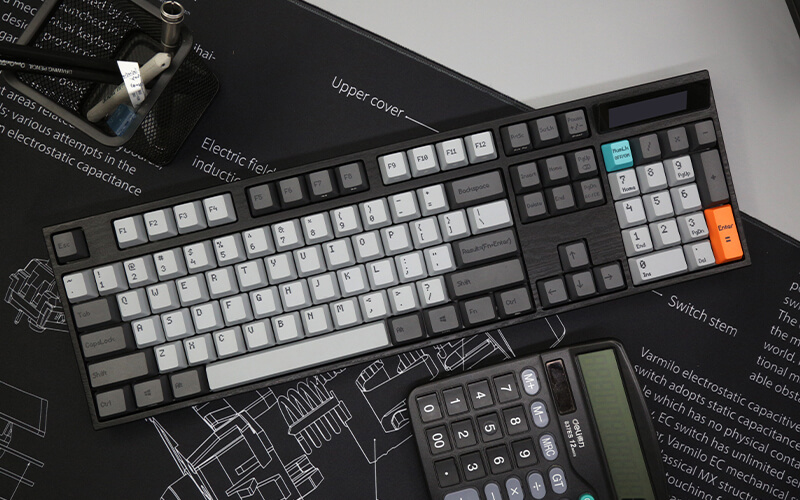Mechanical or membrane keyboard, which one is better? This debate has been going on for a long time. In this article, we analyze their strengths and weakness and see what they bring to the table.
Mechanical keyboards.
Mechanical keyboards are commonly found with keyboard enthusiasts, professionals, and gamers. They enjoy them because of their superior quality and performance. Let us delve deeper into the world of mechanical keyboards.
The mechanical switch.
What makes the mechanical keyboard unique is its mechanical switch. Beneath all the keys on a mechanical keyboard are its dedicated switches. The mechanical switch contains moving parts that are used for actuating a key.
Parts of a mechanical keyboard switch
The mechanical switch comprises of several parts that work together to give you a quick and assured typing experience.
- The stem: The stem is the topmost part of the switch. It moves with each keypress, and it is connected to the keycap.
- Slider: The slider guides the stem downwards when you press a key.
- Upper housing: The upper housing is what houses the stem in the switch.
- The spring: The spring functions to return the stem and keycap. The spring also determines the tension in the switch. Stiffer springs result in a harder key press.
- Metal contact leaves: These are the metals that actuate a key. In a traditional mechanical keyboard, they make contact, and the key is registered. In some versions of mechanical keyboards, there is no need for physical contact to register a key.
- Base housing: like the name suggests is at the base of the mechanical switch. The base housing is connected to the plate or the PCB.
How does a mechanical switch work?
Pressing down on a keycap causes the stem and slider to move in tandem. The slider pushes down and allows the metal leaves in the switch to make contact. When these metals leaves make contact, a circuit is completed, and the key is registered. The spring then returns the stem to its original position.
Types of mechanical switches.
Mechanical switches are made differently. Their designs and structure give them unique feels. Mechanical switches can be broadly categorized into 3.
- Linear switches: Linear switches give a uniform resistance when you press down on a key. The experience can be described as having a smooth typing feel. Examples of linear switches are traditional red switches and the Varmilo EC Sakura. These switches let you type with minimal effort.
- Clicky switches: Clicky switches are the loudest of all mechanical switches. They give auditory feedback of a click or clack, hence their name, clicky switches. A prime example of a clicky switch is a Cherry MX blue.
- Tactile switches: Tactile switches give more subtle feedback than clicky switches. They produce a characteristic bumpy feel when you type with it. The feedback is enjoyable for people who love to type and game. An example of the Tactile switch is the Varmilo EC Rose switch.
Other forms of mechanical keyboards.
Mechanical keyboards are great, and they last a great deal of time, but due to their design, there are limitations. Over time, the metal contact leaves begin to degrade. This is due to abrasion and natural factors such as oxidation. Also, static electricity can cause noise in a mechanical keyboard.
These keyboards have most parts that traditional mechanical switches have. They differ from conventional mechanical keyboards in the way they register keys.
Electrostatic Capacitive Mechanical keyboards: Electrostatic capacitive keyboards do not rely on physical contact to register keys. It uses electrostatic capacitance instead. The contact metals are brought in close contact with each other without touching themselves. The capacitance between the metals changes as their distances vary.
Once the change in capacitance reaches a specific value, the key pressed down is actuated. EC keyboards do not have the limitations of other traditional keyboards. They are faster, last longer, and give the same satisfactory feels on their keyboards.
Optical Mechanical keyboards: Optical keyboards uses light instead of relying on physical contact to register keys.
Pros of a mechanical keyboard.
Durability.
Mechanical switches are made with high-quality materials. They last longer than most keyboards. Mechanical switches can endure about 30-70 million keypresses. Some last even longer, some last more than 80 million keypresses. The Varmilo EC switch employs a contactless mode of use. These switches last longer than traditional mechanical keyboards.
Better typing feels.
Mechanical keyboards have the best typing feels. This primarily depends on the type of mechanical switch present on the keyboard. Many mechanical switches that give three typing feels, linear, tactile and clicky. The devil is in the details; the quality of typing feels also depend on other things. They include the wobbliness, consistency, sound & spring resonance, and smoothness. Categorizing typing feels into three broad categories isn’t ideal. The feel on mechanical keyboards varies from brand to brand.
Faster response time.
Because of their unique design, mechanical keyboards are very responsive to key presses. The average mechanical keyboard takes 6 ms to register a key. This time is much faster than the time it takes a human eye to blink. The Varmilo EC keyboard has a faster response time of less than 5ms. This is very impressive for a keyboard. A mechanical keyboard is a must-have in the world of competitive gaming.
N-Key rollover.
If you mash keys together on membrane keyboards, you will find that there is a limit to the number of keys it can register. This number is known as N-key rollover. It is the maximum number of keys that a keyboard can register at a time. Mechanical keyboards have a higher key rollover than other keyboards.
Some of them have a full key rollover. This makes them highly sought after by professional gamers and people who love to type.
Weight and sturdiness.
Mechanical keyboards are weighty and sturdy. This is a good feature. While typing, your keyboard won’t move easily and remain in a steady position. The weight can be a little discomforting for some, especially when moving them around.
Easy to clean and customizable.
Mechanical keyboards can be easily customized. Keycaps on a mechanical keyboard can be removed to get a more thorough clean. This makes it easy to remove dirt and grime stuck between the keys on the keyboard.
Because keys and switches can be changed, the mechanical keyboard is highly customizable. You can arrange keys and switches according to your preferred layout and style. Some mechanical keyboards come with beautiful themed layouts.
Cons of a mechanical keyboard.
There are three cons to using a mechanical keyboard—price, weight and noise. The experience with weight and noise is subjective.
- Mechanical keyboards are costly.
Mechanical keyboards are made with better technology and durable materials; because of this, they are more expensive than regular keyboards. You are more likely to find a mechanical keyboard with an enthusiast than someone who just uses his/her keyboard for light work.
Given the durability, speed, and typing feel they provide, getting a mechanical keyboard is a worthwhile investment.
- Sound/noise level.
Some people do not like the clicky sound from a mechanical keyboard. They find it annoying and distracting. Fortunately, O-rings can be used to reduce the sound. There is also the option of a tactile keyboard if you need the feedback.
- Weight
Mechanical keyboards are heavier than regular keyboards. This can be a little too much for some keyboards users, especially if they need to carry them around.
Membrane keyboards.
Membrane keyboards are the most common keyboards around. They come with many computers and laptops. The technology is also employed on devices like microwaves and remote controls. They are cheap and easy to mass-produce. They are made like pressure pads that act on a surface.
Membrane keyboards either have a flat key design or a dome switch keyboard. Flat key designs give very poor feedback. They are used on microwaves and other devices.
The dome switch mimics the action of a spring and provides some feedback when typing. It naturally returns to place because of its elasticity.
Scissors switch keyboard: The scissors switch keyboard is a dome switch keyboard with a little modification. Under each keycap is a scissors-like mechanism connected to a plunger. This design reduces travel distance in membrane keyboards. It has a travel distance of 2mm compared to standard membrane switches with a travel distance of 3.5mm – 4mm.
Parts of a membrane Keyboard.
- Top plate: The top plate holds all the keys together in the membrane keyboard.
- IC chip: the integrated circuit chip processes the input from the keyboard and sends it to the computer.
- Top layer: The top layer is made of silicone or rubber. This top layer has conductive traces on it. The domes are embedded in this silicon layer.
- Hole layer: The hole layer separates the top layer from the bottom layer. It acts as a layer of insulation between the top and bottom layers.
- Bottom layer: The bottom layer is the printed circuit board. Just like the top layer, it also has conductive traces running through it.
How membrane keyboards work.
When you press down on a key, the dome pushes on the top layer. Naturally, the two layers do not come in contact because of the hole between the layers. It is analogous to an open circuit. Pressing down on the top layer brings it in contact with the printed circuit board. The contact completes a circuit, and a key is registered. The integrated chip on the keyboard then makes sense of this action and sends it to the computer.
Pros of a membrane keyboard
- Quiet
Rubber and silicone keyboards are excellent sound dampeners. So, naturally, membrane keyboards are very quiet. This is one of the reasons people like membrane keyboards. They can type quietly without any distracting noise.
- Economical.
Membrane keyboards are made with cheap materials, and they are easy to manufacture. They cost less than mechanical keyboards. They are easy to pick up. Many computers come with membrane keyboards. Most users who have a working keyboard find no need to replace them.
- Lightweight and compatible.
Mechanical keyboards are light and easy to carry around. You can also conveniently place them on your laps without feeling too much strain.
Cons of a membrane keyboard
- Not durable
The layers underneath a membrane keyboard can wear out much faster than other keyboards. While typing, you put these materials under tensile, compressive and shear stresses. Compared to metals, rubber and silicon handle stress poorly. Each press you make gradually wears out the switch underneath.
- Slow response time.
The response of membrane keyboards is slow. You have to press each key to the bottom before it registers a key. Membrane keyboards can’t keep up with extremely fast typing speeds.
- Key Rollover.
Their design and materials limit membrane keyboards. They have a limited key rollover, unlike a mechanical keyboard where you can have a full key rollover. Another problem here is ghosting.
- Bad typing feel.
The softness and ‘squishiness’ of the rubber domes make it hard to know when a key has been actuated. Pressing down on a key multiple times will also be delayed. Soft rubber domes won’t return to its original shape as fast as springs in mechanical keyboards do. This is most noticeable during typing. Membrane keyboards can slow you down.
Mechanical keyboards vs. Membrane keyboards.
Let us see how these two keyboard fare when it comes to the following criteria.
Typing feels.
When it comes to typing feels, this comparison may be a little one-sided. Membrane keyboards are improving and try to imitate the feel you would get from a mechanical keyboard. Most membrane keyboards use rubber or silicone layers beneath their keys. This gives them their mushy feel.
The feedback from a membrane keyboard doesn’t feel as reliable as one from a mechanical keyboard. Mechanical keyboards offer a wide range of typing feels. They have stronger and sometimes louder feedback when typing. The quality of the typing feels also vary across manufacturers.
Lifespan.
This is another win by a mile for the mechanical keyboard. Membrane keyboards simply can not outlast them. Mechanical keyboards are better in quality than their membrane counterparts. Compared to metal, the rubber and silicone used in membrane keyboards do not do well under repetitive stress.
The fact that an average membrane switch lasts only a measly 5 million keypresses doesn’t do any good. On average, mechanical switches last 30-70 million keypresses. With advanced mechanical switches like electrostatic capacitive switches, these figures can get higher.
Noise/sound volume.
Mechanical keyboards are loud, much louder than membrane keyboards. While some people love this audio feedback, some people find it annoying. It is essential to know that not all mechanical keyboards are as loud as portrayed.
Keyboards with linear and tactile switches do a better job in the noise department. You can use O-rings to dampen the noise from clicky keyboards.
Membrane keyboards produce less feedback and less noise. They are exceptionally quiet.
Weight.
Mechanical keyboards weigh more than membrane keyboards. They have more parts in them too. Also, it is common to find metal backplate in a mechanical keyboard. Some users love the weight on a keyboard. It is sturdier and won’t wobble much when typing or gaming. However, carrying a heavy keyboard is not fun.
Modularity.
Mechanical keyboards are more modular than membrane keyboards. You can swap keycaps and create beautiful layouts perfectly tailored to your taste. You will be glad to know that there are mechanical keyboards that are hot-swappable. This means you can change the switches without having to solder them. You won’t get this level of modularity on a membrane keyboard.
Ease of cleaning.
Cleaning your peripherals is essential. Dust and dirt can accumulate in your keyboard and affect the performance and reduce lifespan. Spills are also harmful to your keyboard, especially spills from fizzy drinks.
Mechanical keyboards are much easier to clean than membrane keyboards. Apart from removing dirt with a vacuum tube, you can remove the keycaps and key switches in a mechanical keyboard.
You will find this advantageous for thoroughly cleaning your keyboard. Mechanical keyboards also handle spills much better than membrane keyboards. However, some keyboards are more water-resistant than others.
It would be best if you were not drinking anywhere near your keyboard. If you spill a drink, unplug your keyboard, wipe the liquid off with a lint-free cloth, and turn it upside down and leave to dry.
N-key rollover.
Another great feature that mechanical keyboards offer over membrane keyboards is the key rollover.
Even good membrane keyboards are limited to 10 key presses at a time. Mechanical keyboards are capable of registering all keys at the same time.
Disposable nature.
Because of how membrane keyboards are made, they develop faults faster. If a component of a membrane keyboard fails, it may affect the whole thing. Given how fragile membrane keyboards are, you are more likely to cycle through many of them in a few years, especially if you are an avid keyboard user.
As a result, more membrane keyboards have been thrown out than mechanical keyboards. With mechanical keyboards, you can change the keycaps and switches quite easily. Mechanical switches are sometimes soldered on the printed circuit board. Replacing one of these damaged switches is relatively easy.
Cost.
As you should know by now, membrane keyboards are cheaper than mechanical ones. It is a trade-off, performance, and quality for the price.
Which should you buy?
In this showdown between these keyboards, we have established specific facts. Both keyboards have their strengths and weaknesses. The mechanical keyboard has better typing feels, better performance, and it is more durable. If you are a professional or a gamer who needs speed, good feedback, and reliability, you should go for the mechanical keyboard. It is a good investment.
On the other hand, the membrane keyboard is a quieter and cheaper option. If you can deal with the bed typing feel or are on a tight budget, then the membrane keyboard is your go-to keyboard. We believe picking one keyboard over the other shouldn’t be a hard decision.
With all the features of mechanical keyboards, we would be surprised if you did not want one. Even with all their great features, not all mechanical keyboards are made the same. Picking from a sea of options can be a daunting task.
You need a mechanical keyboard that stands out.
The Varmilo EC keyboard.
Varmilo is a peripheral brand which was founded in 2012. Varmilo produces high quality, long-lasting electrostatic capacitive mechanical keyboards.
The Varmilo electrostatic capacitive mechanical keyboard uses electrostatic capacitance. Unlike traditional keyboards, the is no physical contact to register keys. The lifespan of a Varmilo EC switch is practically unlimited. It is more stable, faster, and more sensitive than traditional mechanical keyboards.
Varmilo EC mechanical switches v2 has four typing feels. On these switches, you will find different typing feels that are well-tailored to your lifestyle.
Professionals and users who love a smooth and stress-free typing experience will find the EC Daisy switch to be perfect.
The EC Sakura switch keyboard is for high-end keyboard users who have a high pursuit of keyboard feel and quality of life.
The EC Rose is more than capable for people who love strong confirmatory feedback when typing or gaming.
If you want a keyboard with auditory feedback, then the EC Ivy is the one for you. It has a crisp clicky sound.
Varmilo’s slogan is “Keyboard Artist”. It is a befitting slogan. Every Varmilo keyboard is a masterpiece. Varmilo has made beautiful and elegant theme keyboard layouts that would turn heads. You won’t find this sort of finish and style on any other mechanical keyboard on the market.
